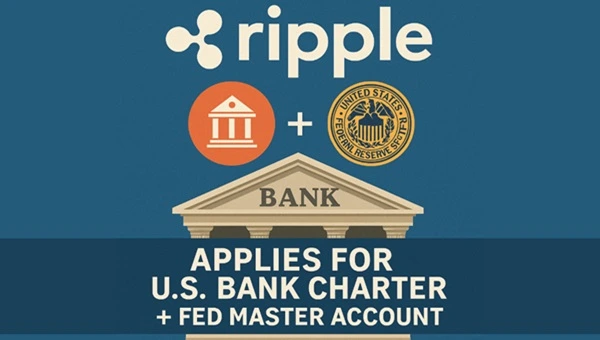

If approved, Ripple would gain the ability to directly hold and manage reserves, issue its stablecoin RLUSD under federal supervision, and plug into the Fed’s payment rails without relying on intermediary banks.
What does a Bank Charter actually do for Ripple?
In short: control, speed, and trust. With a charter in hand, Ripple could operate much like a traditional trust bank, with direct oversight from federal regulators. That means it could hold RLUSD’s backing funds in-house, meet compliance standards familiar to Wall Street, and offer around-the-clock issuance and redemption of the stablecoin.

The Federal Reserve master account—arguably the bigger goal—would grant Ripple direct access to the core of America’s payment infrastructure. That would let it move funds instantly, settle transactions in real-time, and bypass the limitations most fintechs face when they rely on correspondent banks to clear dollars.
In essence, Ripple wants to function like a bank, but one built on blockchain rails.
The Timing
Ripple’s timing isn’t random. It’s joining a growing wave of crypto and fintech firms applying for similar federal charters. Circle, issuer of the USDC stablecoin, is also eyeing a national trust bank license. Anchorage Digital secured one back in 2021 and now operates as a federally chartered crypto bank.
What’s fueling this rush? Regulation. As stablecoins grow in popularity, not just in trading, but also in cross-border payments and tokenized asset settlements, lawmakers are catching up. New legislation is coming, and it’s clear the future will favor compliant, federally supervised players.
Firms that win early approval can position themselves as “safe” options for institutional money. It’s a powerful advantage in a market that still carries reputational risks. Ripple’s new stablecoin, RLUSD, is central to this entire move. Pegged 1:1 to the U.S. dollar, it’s designed for speed, stability, and integration with both decentralized finance (DeFi) and traditional finance systems.
Unlike other stablecoins that may operate in regulatory gray zones, Ripple wants RLUSD to be bulletproof from day one; regulated by the OCC, overseen at the state level via BitLicense, and eventually backed by a Fed master account. That would put RLUSD in a league of its own, at least from a compliance standpoint.
In doing so, Ripple is hoping to attract large institutions that want to experiment with tokenized assets or real-time settlement but won’t touch anything that doesn’t meet traditional finance standards.
Applying for a Fed master account is ambitious and historically, it hasn’t been easy for crypto firms. Kraken and Custodia tried, and both hit regulatory walls. The Fed has been hesitant, often citing concerns about risk and governance.
What sets Ripple apart is its multifaceted compliance framework. It already operates under state oversight and is now seeking full federal supervision. Its trust-focused structure through Standard Custody may also align better with the Fed’s risk appetite compared to other applicants.
Still, approval could take months, or longer. The Fed moves cautiously, and Ripple’s past regulatory battles over XRP could resurface during the review process. Even so, the company’s decision to pursue this route reflects growing confidence in its legal footing and strategic direction.
What Ripple’s doing isn’t just about optics. It’s attempting to reshape what it means to be a financial institution in a tokenized world. If successful, Ripple would blur the lines between crypto firm and bank, offering fully compliant, blockchain-based services with direct ties to the Federal Reserve.
And it wouldn’t just benefit Ripple. Approval could pave the way for other firms to follow a similar model. Traditional banks would be forced to rethink how they approach digital assets, especially if newer players begin offering faster, cheaper, and federally compliant alternatives.
What’s Next?
The OCC review typically takes several months. The Fed master account process is even less predictable. But Ripple’s making a long-term bet here, not just on its own stablecoin, but on a future where crypto doesn’t sit outside the system, but inside it.
The recent passage of a federal stablecoin bill by the Senate suggests the U.S. is finally getting serious about how digital dollars are issued and regulated. Ripple wants to be part of that structure, not skirting around it.
He has worked with several companies in the past including Economy Watch, and Milkroad. Finds writing for BitEdge highly satisfying as he gets an opportunity to share his knowledge with a broad community of gamblers.
Nationality
Kenyan
Lives In
Cape Town
University
Kenyatta University and USIU
Degree
Economics, Finance and Journalism


Facts Checked by Vlad Hategan

 Fact checked by
Fact checked by 
 eabungana@gmail.com
eabungana@gmail.com 